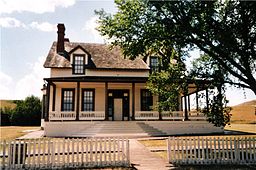Fort Abraham Lincoln
| Fort Abraham Lincoln State Park | |
| North Dakota State Park | |
|
Reproduction of Custer's House
|
|
| Country | United States |
|---|---|
| State | North Dakota |
| County | Morton |
| Elevation | 1,722 ft (525 m) |
| Coordinates | 46°45′51″N 100°50′59″W / 46.76417°N 100.84972°WCoordinates: 46°45′51″N 100°50′59″W / 46.76417°N 100.84972°W |
| Area | 1,006 acres (407 ha) |
| Established | 1907 |
| Management | North Dakota Parks and Recreation Department |
| Website: Fort Abraham Lincoln State Park | |
Fort Abraham Lincoln State Park is a North Dakota state park located 7 miles (11 km) south of Mandan, North Dakota, United States. The park is home to the On-A-Slant Indian Village and reconstructed military buildings including the Custer House.
The Mandan Indian tribe established a village at the confluence of the Missouri and Heart rivers in about 1575. They built earth lodges and thrived in their community by hunting bison and growing a number of crops. Two hundred years later, an outbreak of smallpox significantly decreased the Mandan population and the survivors resettled to the north. In June 1872, at the same location where the Mandan tribe had established their village, a military post named Fort McKeen was built by two companies of the 6th U.S. Infantry under Lt. Col. Daniel Huston, Jr., opposite Bismarck, Dakota Territory.
The three-company infantry post's name was changed to Fort Abraham Lincoln on November 19, 1872, and expanded to the south to include a cavalry post accommodating six companies. Among the 78 permanent wooden structures at Fort Lincoln were a post office, telegraph office, barracks for nine companies, seven officer’s quarters, six cavalry stables, a guardhouse, granary, quartermaster storehouse, bakery, hospital, laundress quarters, and log scouts' quarters. Water was supplied to the fort by being hauled from Missouri River in wagons, while wood was supplied by contract.
By 1873, the 7th Cavalry moved into the fort to ensure the expansion of the Northern Pacific Railway. The first post commander of the expanded fort was Lieutenant Colonel George A. Custer, who held the position until his death in 1876.
In 1876, the Army departed from here as part of the Great Sioux War of 1876-77, resulting in Custer's defeat at the Battle of the Little Bighorn, where they were to push the non-treaty Indians back to their particular reservations. Custer along with about half of his troops did not return to Fort Lincoln. The Fort was abandoned in 1891 after the completion of the railroad to Montana in 1883. A year after the fort was abandoned; local residents disassembled the fort for its nails and wood. In 1895, a new Fort Lincoln was built across the river near Bismarck. In 1907, President Theodore Roosevelt signed the deed to the original fort's land over to the state as Fort Abraham Lincoln State Park.
...
Wikipedia


